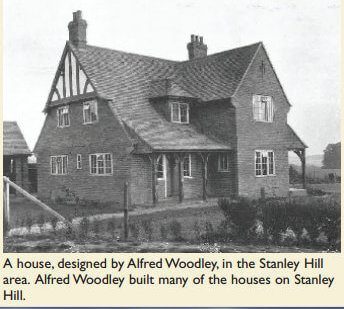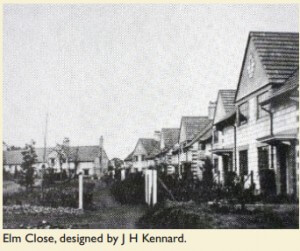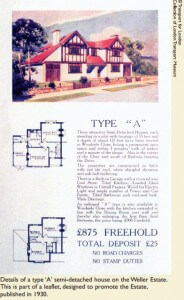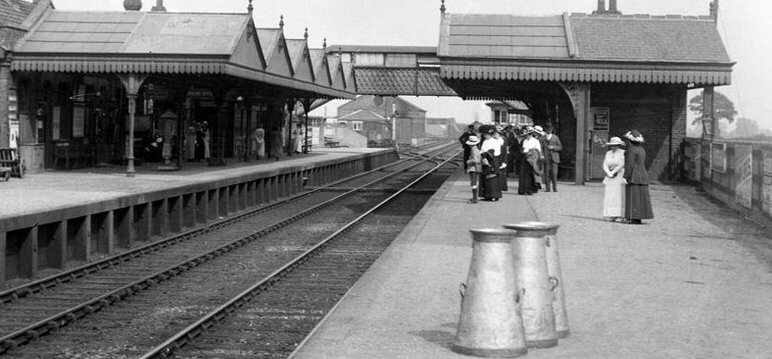This article was written for the 2013 Metro-land exhibition
The rapid growth of new shops and housing in the 1920s and 1930s was driven forward by local architects and builders as much as by the Metro-land developments. New roads were laid out in Amersham-on-the-Hill, with new houses developed by builders such as Alfred Woodley, Robin Brazil and George Darlington. Over 2,300 houses were built between 1921 and 1931.
 Alfred Woodley was one of the most prolific builders in the 1920s, employing over 200 people in his firm. He lived in South Road and had a shop and builder’s yard in Lexham Gardens. He built many of the houses on Stanley Hill and became a landlord, renting out houses in Highland Road and Quarrendon Road. He also built and part owned the Regent Cinema on Sycamore Road.
Alfred Woodley was one of the most prolific builders in the 1920s, employing over 200 people in his firm. He lived in South Road and had a shop and builder’s yard in Lexham Gardens. He built many of the houses on Stanley Hill and became a landlord, renting out houses in Highland Road and Quarrendon Road. He also built and part owned the Regent Cinema on Sycamore Road.
 There were some more unusual houses too. J H Kennard designed Elm Close, just off Hill Avenue. Built in 1920 for the Amersham Public Utility Society,the 30 semi-detached houses were built with a state subsidy. Given the lack of materials after the war, the houses were built from concrete blocks which were cast on site.
There were some more unusual houses too. J H Kennard designed Elm Close, just off Hill Avenue. Built in 1920 for the Amersham Public Utility Society,the 30 semi-detached houses were built with a state subsidy. Given the lack of materials after the war, the houses were built from concrete blocks which were cast on site.
The most iconic building in Amersham is High & Over. Designed by Amyas Connell in 1929 it was the first Modernist ‘international style’ country house in Britain. It was the home of Bernard Ashmole, Professor of Classical Archaeology at London University, and his family.
 Social housing began to emerge after the First World War. For the first time local councils took responsibility for those in need and built homes for them. Houses were built on Stanley Hill, White Lion Road, Plantation Road and in Piggott’s Orchard in the old town.
Social housing began to emerge after the First World War. For the first time local councils took responsibility for those in need and built homes for them. Houses were built on Stanley Hill, White Lion Road, Plantation Road and in Piggott’s Orchard in the old town.
Metro-land
Amersham’s Weller Estate was the last and furthest from London of the Metro-land estates. The developments were designed and built to encourage people to move out of London and use the railway for commuting. The estates are unique to the Met; the railway’s managers took advantage of a Railway Act that enabled surplus lands around the railway to be developed for housing.
 Managed from 1919 by a separate company, the Metropolitan Railway Country Estes (MRCE), these developments were advertised to Londoners tired of living in overcrowded conditions. The Metropolitan ideal was of new houses set in idyllic countryside within an easy journey from London for work, shopping and entertainment.
Managed from 1919 by a separate company, the Metropolitan Railway Country Estes (MRCE), these developments were advertised to Londoners tired of living in overcrowded conditions. The Metropolitan ideal was of new houses set in idyllic countryside within an easy journey from London for work, shopping and entertainment.
 The Weller Estate was launched in 1930. It consisted of 78 acres of land north and south of the station between Grimsdell’s Lane and Stanley Hill Avenue, bought from the estate of George Weller for £18,000. The plans included 535 houses and 51 shops.
The Weller Estate was launched in 1930. It consisted of 78 acres of land north and south of the station between Grimsdell’s Lane and Stanley Hill Avenue, bought from the estate of George Weller for £18,000. The plans included 535 houses and 51 shops.
Four types of houses were proposed, ranging in price from £875 to £1,200. They can be found today around the station; Woodside Close, Highfield Close, Woodside Road, The Drive and The Rise contain typical Metro-land houses.
 Not all of the Weller Estate was built. There were plans to develop what is now King George V Field for housing and the site of the current council offices for shops.
Not all of the Weller Estate was built. There were plans to develop what is now King George V Field for housing and the site of the current council offices for shops.


